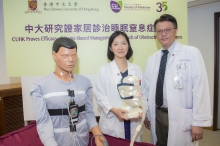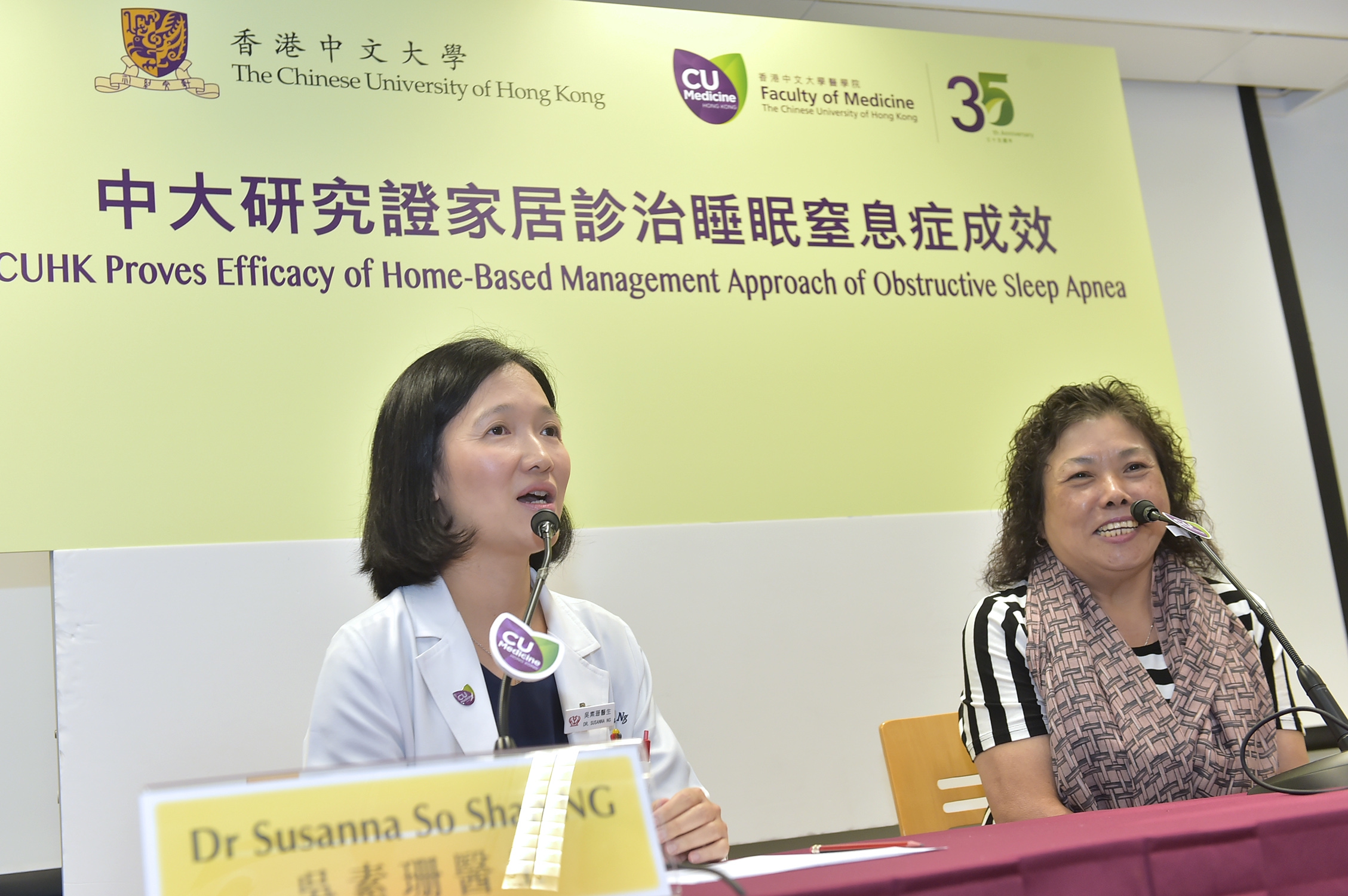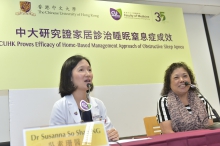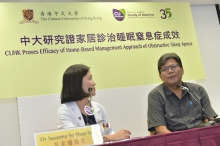News Centre
CUHK Proves Efficacy of Home-Based Management Approach of Obstructive Sleep ApnoeaApplicable to 50% of Public Hospital Adult Cases with Waiting Time Reduced by 80%
The Faculty of Medicine at The Chinese University of Hong Kong (CUHK) studied and compared two different approaches of diagnosis and management of obstructive sleep apnoea (OSA). The study proves that the ambulatory approach is non-inferior to the conventional hospital-based practice, but the former offers greater overall benefits to adult patients by shortening 80% waiting time and substantially lowering medical costs. The findings have been recently published in the international scientific journal Nature – Scientific Reports.
Untreated OSA increases risk of cardiovascular diseases
OSA is a common form of sleep-disordered breathing. When the patient sleeps, the upper airway is obstructed which leads to a reduction of oxygen in the blood, hence causing sleep fragmentation, disabling daytime sleepiness and impaired cognitive function. Untreated patients bear a higher risk of cardiovascular diseases, such as heart failure or stroke. According to studies, the prevalence rate of OSA among middle-aged men is 5% and 2-3% for women.
Dr Susanna So Shan NG, Clinical Assistant Professor (Honorary), Department of Medicine and Therapeutics at CUHK said, ‘Ageing, male, obesity, craniofacial factors such as small chin, enlarged tonsils, large neck size are all risk factors of OSA.’
Diagnosis and treatment of OSA
The Apnoea-hypopnea index (AHI) is used to reflect the severity of OSA. It is a count of the number of upper airway obstructions per hour of sleep, with 5 to 15 events being mild and 15 to 30 moderate. More than 30 events is considered severe.
Sleep tests are used to diagnose OSA, in which a machine will be used to measure patients’ oxygen saturation, airflow, respiratory effort, as well as other indexes including body position, snoring, heart rate. Continuous positive airway pressure (CPAP) is a common therapy which helps to prevent airway closure during sleep and hence to improve patients’ sleep quality, cognitive function and blood pressure, but it has to be used continuously during sleep. Depending on the severity, other treatment options include dental device and surgery.
The conventional sleep test, namely polysomnography, is hospital-based and is used in most public hospitals in Hong Kong. However, limited beds and medical resources could mean a lengthy waiting period of up to 12 months. The home-based sleep test is an alternative available in Hong Kong for only a few years that allows adult patients to do the test at home with a portable device provided by specialists. Currently 40% of adults attending the Respiratory Clinic of the Prince of Wales Hospital with OSA symptoms are referred to the Faculty and are using this service.
Study shows home-based approach can cut 80% waiting time and reduce medical expenses
In order to study and compare the efficacy of the two approaches in managing OSA, the Faculty of Medicine at CUHK recruited 316 new referrals with OSA symptoms between September 2013 and August 2014, dividing them into two groups: home-sleep-study group and hospital-based group.
Prof. David Shu Cheong HUI, Chairman and Stanley Ho Professor of Respiratory Medicine, Department of Medicine and Therapeutics at CUHK, stated, ‘Our results showed that the home-based approach outperformed the conventional method in all aspects. Patients had greater improvement in daytime sleepiness and quality of life, and showed better cognitive function. Besides, these patients tended to be more adherent to CPAP treatment and had a higher usage per night. I believe patients may feel more relaxed in their home setting and thus a better therapeutic effect is yielded.’
Comparison of waiting time of the ‘home-sleep-study’ group and ‘hospital-based’ group:
|
|
Home based |
Hospital based |
|
Received sleep test |
157 patients |
159 patients |
|
Waiting time between 1st consultation to diagnostic sleep test |
59 days |
249 days |
|
|
||
|
Diagnosed with moderate to severe OSA (AHI≥15),received and completed 3-month CPAP treatment |
86 patients |
86 patients |
|
Waiting time between 1st consultation to CPAP titration |
117 days |
266 days |
|
Waiting time between 1st consultation to CPAP treatment |
155 days |
300 days |
The results showed that the ambulatory home-based sleep test approach could reduce 6 months, i.e. 80%, of waiting time. The waiting time for CPAP titration and CPAP treatment is also reduced by 5 months. It is estimated that the new approach can save almost HK$14,000 medical costs for each adult patient compared to the hospital-based approach.
Professor Hui concluded, ‘From our experience, the ambulatory sleep test machine and ambulatory CPAP devices are very user-friendly. Patients can easily manage the operation of the device at home following simple instructions from the medical staff. A shorter waiting time is crucial to OSA patients which may lower their risk of cardiovascular diseases caused by delayed treatment. The American Academy of Sleep Medicine has recently issued a new guideline[1]this year, recommending the use of home sleep apnoea testing for adult patients with signs and symptoms that indicate moderate to severe OSA. We estimate that half of the public hospital patients with OSA in Hong Kong can benefit from this ambulatory approach, but not including the complicated cases. Since the complexity of OSA varies in different cases, professional medical advices are crucial throughout diagnosis and treatment.’
[1] American Academy of Sleep Medicine Clinical Practice Guideline
http://www.aasmnet.org/Resources/clinicalguidelines/diagnostic-testing-OSA.pdf

A recent study led by Prof. David Shu Cheong HUI (right), Chairman and Stanley Ho Professor of Respiratory Medicine, Department of Medicine and Therapeutics, and Dr Susanna So Shan NG, Clinical Assistant Professor (Honorary), Department of Medicine and Therapeutics, CUHK Faculty of Medicine, proves that the ambulatory approach of managing obstructive sleep apnoea (OSA) can shorten 80% waiting time and substantially lower medical costs.




